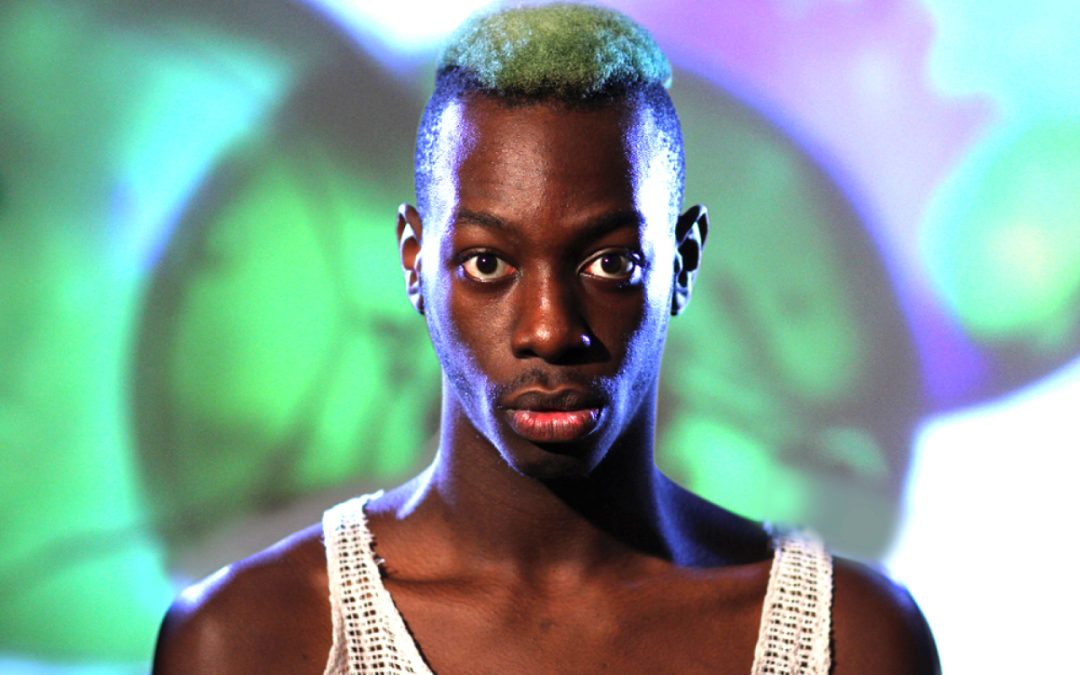There is a moment in the video for Wut, by New York rapper Le1f, that I feel we should discuss. In it, Le1f—understated in a jersey, athletic shorts and a gold chain—perches on the lap of a man. The man is muscular and white, his body coated in oil, his face obscured by a Pikachu mask. He doesn’t move as Le1f ferociously dips and twirls and gyrates on and around him. The man, we are given to understand, is only there as carnal furniture, a throne upon which Le1f may lounge and dance while he spits out verses like: Ukrainian cutie/ he really wanna cuddle/ the fever in his eyes/ he wanna suckle on my muscle.
In a little under 30 seconds Le1f completely inverts the cultural objectification of his own black body, destroying the white male gaze by placing himself in a position of power and relegating the fit, white figure to nothing more than a decorative embellishment. To my mind, few other moments express the political power and aesthetic singularity of queer hip-hop quite as succinctly as this. Expectations are reversed, power matrices are inverted, rhymes are slung, and framing it all is a delicate filagree of fabulousness.
Exploding into the cultural forefront in the last few years, queer hip-hop has emerged as one of the most transformative and politically-charged forces in the musical underground. It’s a social movement as much as it’s a specific genre.
It’s not difficult to understand how hip-hop—a subculture that has broadcast messages of radical social change and political upheaval since its inception—would be adopted as the primary medium for queer artists of color who felt a desire to speak to their own experiences. In its most inspired moments queer hip-hop is capable of transmitting the kind of revolutionary musical politics that creates real action, akin to the Riot Grrrl movement of the early 90s which helped usher in third-wave feminism.
Riot Grrl, whose message of political revolution was broadcast to the masses via the mainstream success of bands like Sleater-Kinney and Hole (who, despite no actual affiliation with the movement in the case of Hole, or quickly evolving past such easy classification of genre à la Sleater-Kinney) managed to create enough of a bridge to the mainstream to popularize feminist punk music and by association its politics. Despite the similarities there still exists a major difference. Queer hip-hop has remained in the underground.
The methods by which a musician or musical gains mass-appeal are vague and nebulous at best, and entire swaths of the music industry are constantly engaged in the search for The Next Big Thing. Yet, despite sizable amounts of press coverage, queer hip-hop seems unable to make its way onto a national stage.
Certainly there are drawbacks to commercial success, but in the landscape of today’s music industry—with the concept of “selling out” essentially destroyed by the democratizing effects of the internet—having a breakthrough record is not the creative death sentence it might once have been.
With the contemporary LGBT rights movement in somewhat of an identity crisis post-marriage equality, and with the emergence of #BlackLivesMatter as a major activist movement, there is a distinct need for more queer people of color in the cultural eye. In this light, queer hip-hop seems poised to emerge as a dominating artistic force in the 21st century- and yet, nothing.
Obviously there have been flirtations with mainstream success.
- Zebra Katz
- Mykki Blanco
Azealia Banks courted massive commercial attention with a string of successful mixtapes, viral hits (212) and a highly anticipated debut album (Broke With Expensive Tastes), but lately her career has been eclipsed by an onslaught of bizarre, offensive Twitter beefs and run-ins with the law.
Rappers like Zebra Katz and Cakes da Killa have received positive press, each releasing singles that sound almost radio-friendly. However Katz’s latest release, Nu Renegade, is a giant step away from the electro-rap orientation of singles like Ima Read, or Tear the House Up towards something darker and more akin to ballroom EDM, and Cakes seems to lack the marketing power of his contemporaries despite positive critical reception of tracks like Goodies.
Another New York rapper, Mykki Blanco, has achieved a level of notoriety, vis-a-vis aggressive gender-bending as much as her music, but Blanco has consistently released music that seems to want to be underground. Honestly it’s hard to picture anybody picking up and really getting Mykki Blanco presents C-ORE, her most recent LP, unless they’re a pretty hardcore fan already.
Le1f of course has been hailed as the scion of the movement, poised to lead queer hip-hop into mainstream consciousness. But, despite all the hype, the release of his debut album Riot Boi seemed to be greeted with little more than the obligatory blog reviews and a pat on the back.
Perhaps though, the question should not be who will bring queer rap to the masses, but if such a cross-over is even desirable. It seems more than possible that more than one of the major players in the queer hip-hop scene could harness the zeitgeisty pluralism of pop culture and launch themselves onto a national stage.
But what would be the implications for the movement as a whole? It’s a question that subcultural creators have been forced to ask themselves over and over: Can art remain transgressive if it achieves commercial success and necessarily loses its outsider status?
It’s difficult to ascertain what the future of queer hip-hop holds and whether it will manage to ascend into the realm of pop consciousness or fizzle out like countless micro-genres before it. But its hard not to feel hopeful watching Le1f dropping it like it’s hot next to his Pikachu-Adonis. If he and his contemporaries can continue create music that addresses hetero-normativity, transphobia, and racism while also making me want shake my ass, maybe there’s hope yet.
[wc_spacing size=”40px”]
[wc_divider style=”solid” line=”single” margin_top=”” margin_bottom=””]




You must be logged in to post a comment.